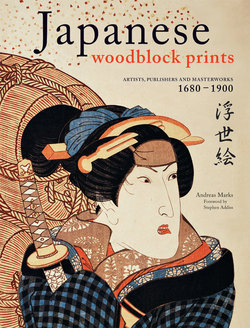Читать книгу Japanese Woodblock Prints - Andreas Marks - Страница 36
На сайте Литреса книга снята с продажи.
ОглавлениеToyokuni
1769–1825
Family name: Kurahashi. Given names: Kumakichi, Kumaemon. Art surname: Utagawa. Art name: Ichiyōsai.
Born in 1769 in Shinmeimae Mishimachō of Edo’s Shiba district as the son of a dollmaker, Toyokuni became the most important student of Toyoharu, the founder of the Utagawa school. The illustrations to the book “Sleeping and Waiting Fool” (Ahōha nete mate) from 1786 seems to be his first known work whereas his earliest print is a portrait of the actor Segawa Kikunojō III (1751–1810) in the female role Tsunaga dated to the ninth month 1789.
In the early 1790s, he followed his teacher Toyoharu by also designing a series of perspective prints. Toyokuni’s early images of beautiful women, influenced by Kiyonaga, appear austere and are usually set in landscapes. In his later years, his beauties are much more accomplished. From time to time, Toyokuni also designed warrior prints.
The overwhelming majority of Toyokuni’s works are related to the kabuki theatre. He became close friend with some of the important actors of his time and drew also actors behind the scenes and in private life offstage or memorial portraits once a popular actor passed away. The figure on the upper right from c.1811 depicts the actor Sawamura Sōjūrō IV (1784–1813) looking at a billboard. The publisher Izumiya Ichibei issued Toyokuni’s innovative series “Likenesses of Actors on Stage” (Yakusha butai no sugata-e) from 1794 until 1796, through which he became famous. The novel, vivid sense of realism in these more than fifty portraits set the stage for the future development in actor portraiture. Especially in his large-head (ōkubi-e) and in his double bust portraits he emphasized the actors’ individual features and created powerful expressions. From the late 1790s until the 1810s he preceded the market of actor prints that were now, like prints of beautiful women, issued in the popular large ōban format, contrary to the previously dominant narrow hosoban format. In the fifth month of 1804, he was one of the artists who were manacled for fifty days for illustrating the events and identifiable figures from the Ehon Taikōki (Illustrated Chronicles of the Regent) in his prints.
With over ninety print series and many hundreds of single sheet, unserialized prints, Toyokuni was one of the most prolific and sought-after print artists. In his almost thirty year long career he worked for over one hundred publishers and also produced a few paintings. He illustrated over 400 books (some wiTherotic content); only his student Kunisada surpassed this number. Most importantly is the drawing manual for leading actors of the time, “Quick Instructions in Actor Likenesses” (Yakusha nigao haya geiko), published in 1817. Toyokuni’s success was the decisive factor to establish the Utagawa School as the most productive and influential school of the late Edo period and he firmly set its reputation as specialists in actor prints. Amongst his many students were Kunisada, Kunimasa, Kuniyasu, and Kuniyoshi.
Active until his final day, Toyokuni died at the age of 57 on the seventh day of the first month 1825. He received the posthumous Buddhist name Tokumyōin Jissaireigō Shinji and is buried at the Banshōin Kōunji. Immediately after Toyokuni passed away, two memorial portraits by Kunisada were issued.
c.1811 The actor Sawamura Sōjūrō IV looking at a billboard. ōban. Publisher: Unidentified. Collection Arendie and Henk Herwig.
1794 The actor Segawa Kikunojō III (“Hamamuraya”)as Katsuragi in the play Keisei sanbon kara kasa, Miyako Theater, VII/1794, from the series “Likenesses of Actors on Stage” (Yakusha butai no sugata-e). ōban. Publisher: Izumiya Ichibei. Collection Peter Rieder.
1800 The actors Ichikawa Danjūrō VII as Terusada, Segawa Kikunojō III as Unoha, Ichikawa Hakuen I as ōtomo Yamanushi in the play Oi shigeru nami no uneune, Ichimura Theater, XI/1800. ōban. Publisher: Nishimuraya Yohachi. Collection Peter Rieder.
1813 The actor Ichikawa Danjūrō VII as Miura Ara Otokonosuke in the play Shikisemono Soga no datezome, Morita Theater, I/1813. ōban. Collection Peter Rieder.
c.1795 Daruma as a woman. ōban. Publisher: Harimaya Shinshichi. Asian Art Museum, National Museums in Berlin.
1800s “A procession of flowers before Mount Fuji” (Fujibitai hana no gyōretsu). ōban pentaptych. Publisher: Yamamoto Kyūbei. Library of Congress.
early 1820s The retainers of the Four Heavenly Kings—Minamoto no Yorimitsu Ason, Usui Aratarō Sadamitsu, Ichihara no Kidōmaru, Watanabe Genjitsuna. ōban diptych. Publisher: Moritaya Hanzō and Tsutaya Kichizō. Library of Congress.
Late 1790s “Act ten” (Jū danme), from the series “Treasury of Loyal Retainers” (Chūshingura). ōban. Publisher: Nishimuraya Yohachi. Asian Art Museum, National Museums in Berlin.
